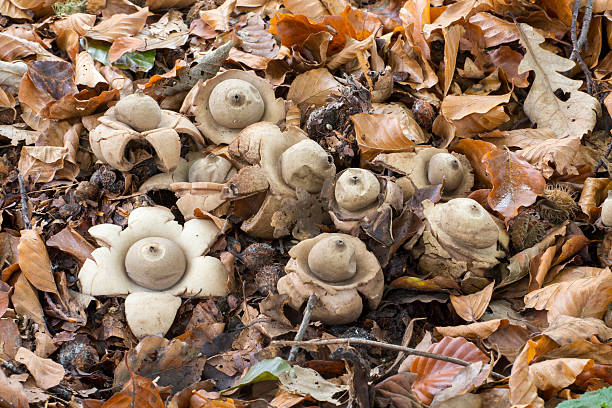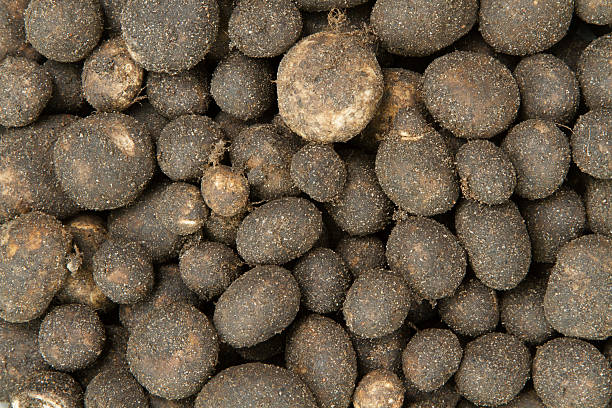
Collared earthstar (Geastrum triplex) - the Netherlands
Browse 410+ earthstar mushroom stock photos and images available, or start a new search to explore more stock photos and images.

Collared earthstar (Geastrum triplex) - the Netherlands

Collared earthstar (Geastrum triplex) - the Netherlands

Collared earthstar (Geastrum triplex) - the Netherlands

Collared earthstar (Geastrum triplex) - the Netherlands

Collared earthstar (Geastrum triplex) - the Netherlands

Geastrum triplex is an inedible fungus which is found in the detritus and leaf litter of hardwood forests in many parts of the world.More photos of this series :

Collared earthstar (Geastrum triplex) - the Netherlands

Mushroom Hygroscopic earthstar or False earthstar in wooden bowl on white background with clipping path.

Mushroom Hygroscopic earthstar or False earthstar or Barometer earthstar full and half on white background with clipping path.

Myriostoma is a fungal genus in the family Geastraceae. The genus is monotypic, containing the single species Myriostoma coliforme. It is an earthstar, so named because the spore-bearing sac's outer wall splits open into the shape of a star. The inedible fungus has a cosmopolitan distribution, and has been found in Africa, Asia, North and South America, and Europe, where it grows in humus-rich forests or in woodlands, especially on well-drained and sandy soils. A somewhat rare fungus, it appears on the Red Lists of 12 European countries, and in 2004 it was one of 33 species proposed for protection under the Bern Convention by the European Council for Conservation of Fungi. The fruit body, initially shaped like a puffball, is encased within an outer covering that splits open from the top to form rays. These rays curve down to expose an inner papery spore case, which contains the fertile spore-bearing tissue, the gleba. The fungus is unique among the earthstars in having a spore case that is supported by multiple stalks, and is perforated by several small holes suggestive of its common names salt-shaker earthstar and pepperpot. It is the largest of the earthstar fungi, and reaches diameters of up to 12 cm. Its spherical spores have elongated warts that create a ridge-like pattern on their surface. The spores are dispersed when falling water hits the outer wall of the spore sac, creating puffs of air that force the spores through the holes (source Wikipedia). This nice Species is found in the Coastal Sand Dunes in the Netherlands. It is quite rare in these Regions.

Myriostoma is a fungal genus in the family Geastraceae. The genus is monotypic, containing the single species Myriostoma coliforme. It is an earthstar, so named because the spore-bearing sac's outer wall splits open into the shape of a star. The inedible fungus has a cosmopolitan distribution, and has been found in Africa, Asia, North and South America, and Europe, where it grows in humus-rich forests or in woodlands, especially on well-drained and sandy soils. A somewhat rare fungus, it appears on the Red Lists of 12 European countries, and in 2004 it was one of 33 species proposed for protection under the Bern Convention by the European Council for Conservation of Fungi. The fruit body, initially shaped like a puffball, is encased within an outer covering that splits open from the top to form rays. These rays curve down to expose an inner papery spore case, which contains the fertile spore-bearing tissue, the gleba. The fungus is unique among the earthstars in having a spore case that is supported by multiple stalks, and is perforated by several small holes suggestive of its common names salt-shaker earthstar and pepperpot. It is the largest of the earthstar fungi, and reaches diameters of up to 12 cm. Its spherical spores have elongated warts that create a ridge-like pattern on their surface. The spores are dispersed when falling water hits the outer wall of the spore sac, creating puffs of air that force the spores through the holes (source Wikipedia). This nice Species is found in the Coastal Sand Dunes in the Netherlands. It is quite rare in these Regions.

Myriostoma is a fungal genus in the family Geastraceae. The genus is monotypic, containing the single species Myriostoma coliforme. It is an earthstar, so named because the spore-bearing sac's outer wall splits open into the shape of a star. The inedible fungus has a cosmopolitan distribution, and has been found in Africa, Asia, North and South America, and Europe, where it grows in humus-rich forests or in woodlands, especially on well-drained and sandy soils. A somewhat rare fungus, it appears on the Red Lists of 12 European countries, and in 2004 it was one of 33 species proposed for protection under the Bern Convention by the European Council for Conservation of Fungi. The fruit body, initially shaped like a puffball, is encased within an outer covering that splits open from the top to form rays. These rays curve down to expose an inner papery spore case, which contains the fertile spore-bearing tissue, the gleba. The fungus is unique among the earthstars in having a spore case that is supported by multiple stalks, and is perforated by several small holes suggestive of its common names salt-shaker earthstar and pepperpot. It is the largest of the earthstar fungi, and reaches diameters of up to 12 cm. Its spherical spores have elongated warts that create a ridge-like pattern on their surface. The spores are dispersed when falling water hits the outer wall of the spore sac, creating puffs of air that force the spores through the holes (source Wikipedia). This nice Species is found in the Coastal Sand Dunes in the Netherlands. It is quite rare in these Regions.

Myriostoma is a fungal genus in the family Geastraceae. The genus is monotypic, containing the single species Myriostoma coliforme. It is an earthstar, so named because the spore-bearing sac's outer wall splits open into the shape of a star. The inedible fungus has a cosmopolitan distribution, and has been found in Africa, Asia, North and South America, and Europe, where it grows in humus-rich forests or in woodlands, especially on well-drained and sandy soils. A somewhat rare fungus, it appears on the Red Lists of 12 European countries, and in 2004 it was one of 33 species proposed for protection under the Bern Convention by the European Council for Conservation of Fungi. The fruit body, initially shaped like a puffball, is encased within an outer covering that splits open from the top to form rays. These rays curve down to expose an inner papery spore case, which contains the fertile spore-bearing tissue, the gleba. The fungus is unique among the earthstars in having a spore case that is supported by multiple stalks, and is perforated by several small holes suggestive of its common names salt-shaker earthstar and pepperpot. It is the largest of the earthstar fungi, and reaches diameters of up to 12 cm. Its spherical spores have elongated warts that create a ridge-like pattern on their surface. The spores are dispersed when falling water hits the outer wall of the spore sac, creating puffs of air that force the spores through the holes (source Wikipedia). This nice Species is found in the Coastal Sand Dunes in the Netherlands. It is quite rare in these Regions.

Astraeus hygrometricus, Black Barometer Earthstars Mushrooms in Chiang Mai ,Thailand

Delicious wild mushroom. Thai word "Hed Thop", Hand show inside old mushroom

Thai mushroom soup with tamarind leaves,Barometer Earthstars, hygroscopic earthstar, false earthstar.

Thai mushroom soup with tamarind leaves,Barometer Earthstars, hygroscopic earthstar, false earthstar.

Fresh Barometer Earthstars, mushroom from Thailand in blue basket

Thai mushroom soup with tamarind leaves,Barometer Earthstars, hygroscopic earthstar, false earthstar.

Thai mushroom soup with tamarind leaves,Barometer Earthstars, hygroscopic earthstar, false earthstar.

Thai mushroom soup with tamarind leaves,Barometer Earthstars, hygroscopic earthstar, false earthstar.

Thai mushroom soup with tamarind leaves,Barometer Earthstars, hygroscopic earthstar, false earthstar.

Thai mushroom soup with tamarind leaves,Barometer Earthstars, hygroscopic earthstar, false earthstar.

Barometer Earthstars or earthstar mushroom or in Thai word “Hed Thop” the very pupura mushroom in northen thailand

Barometer Earthstars on sell in market

Local people in Thailand they are collected from the wild and sold in the markets for cooked as food.

Common mushroom growing in grass. Centered image. . High quality photo

big pile of fresh potatoes in a market ready for sale

Barometer isolated on white background

Macro photography of an earthstar fungus (Geastrum species) captured in a natural forest habitat. Detailed texture and earthy tones highlight the unique structure of the fungus. Suitable for concepts related to nature, biodiversity, forest ecosystems, and mycology.

Natural closeup on the odd shaped collared,, saucered or triple earthstar mushroom, Geastrum triplex, growing on the forest floor

Macro photography of an earthstar fungus (Geastrum species) captured in a natural forest habitat. Detailed texture and earthy tones highlight the unique structure of the fungus. Suitable for concepts related to nature, biodiversity, forest ecosystems, and mycology.

Geastrum triplex is an inedible fungus which is found in the detritus and leaf litter of hardwood forests in many parts of the world. It is commonly known as the collared earthstar, the saucered earthstar, or the triple earthstar—and less commonly by the alternative species name Geastrum indicum

Local people in Thailand they are collected from the wild and sold in the markets for cooked as food.

Barometer earthstar or Hygroscopic earthstar (Astraeus hygrometricus) ,Thai naturally occurring mushrooms on banana leaf background

Mushroom Hygroscopic earthstar or Barometer earthstar or False earthstar in a wooden bowl on white background with clipping path

Top view of freshly harvested natural musroom Hygroscopic earthstar from the soil in the forest of Thailand collect in a bamboo basket on the wooden floor.

Closeup of fringed earthstar, Geastrum fimbriatum.

Closeup of fringed earthstar, Geastrum fimbriatum.